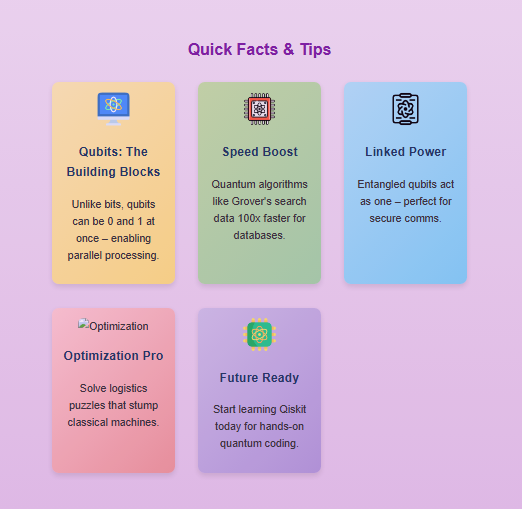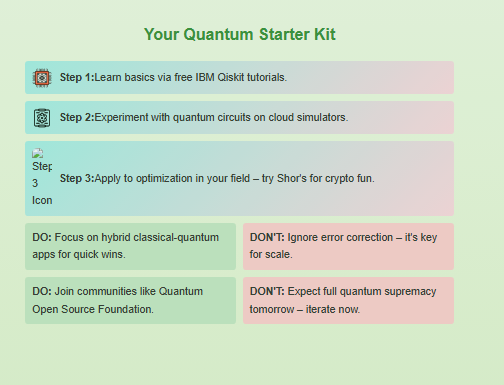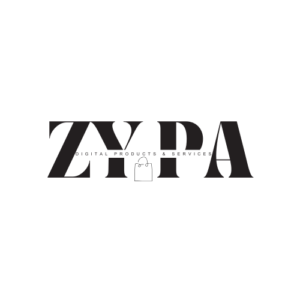AI-powered video editing, instantaneous worldwide communication, and amazing digital marketing automation tools are all part of our modern environment. However, all of our favorite content production software—from Photoshop to Final Cut Pro—are powered by classical computers, which are built on a straightforward, half-century-old concept: a switch is either ON (1) or OFF (0). However, what if a switch could be simultaneously and off? It’s not a puzzle. It’s the reality of quantum computing, a technology that’s transitioning from science fiction to a genuine, multibillion-dollar enterprise. This technique claims to solve issues that are impossible for even the most potent supercomputers available today, in addition to being faster.

Quantum computing is happening right now, not in the far future. Additionally, a few forward-thinking businesses are competing to change our understanding of time, speed, and computation in general.
What is Quantum Computing? → A Comparative Analysis
Let’s acquire a precise, visual definition before we meet the players.
Consider this instead of the perplexing “it’s a 1 and a 0 at the same time.”
The Analogy of the Spinning Coin
Similar to a coin resting flat on a table, a classical bit is either Heads (1) or Tails (0). Clear. Easy.
A quantum bit, often known as a “qubit,” is similar to that coin when it’s spinning in the air.
It’s not heads or tails while it’s whirling. It has the probability of turning into either. It only collapses into a definitive condition of heads or tails when you “measure” it (slap it on the table).
Millions of calculations are made on these “spinning coins” simultaneously by a quantum computer. A quantum computer can investigate a large number of options simultaneously thanks to a feature known as superposition, which gives it an exponential speedup for some tasks.
Also Read: What Is AGI? Truth About Artificial General Intelligence

Creator’s Flashcard: Key Terms in Quantum Computing
Do you want to sound knowledgeable? These are the three terms you should be familiar with.
Flashcard:
The fundamental unit of quantum information is called a quantum bit, or qubit. A qubit can exist in a state of superposition, in contrast to a traditional bit (1 or 0).
The ability of a qubit to simultaneously be in both 1 and 0 states (like a spinning coin) is known as superposition.
When two or more qubits are connected in a way that is not feasible in classical physics, this phenomenon is known as entanglement. No matter how far apart they are, you can immediately determine the other's condition when you measure one. It was described by Einstein as "spooky action at a distance."
The Real-World Competition → Quantum vs. Classical
So why is this even necessary? Willn’t Moore’s Law-powered classical computers continue to advance?
They do have a ceiling, though. Classical computers excel at linear tasks, or what we refer to as “brute force.” However, they struggle with extremely complicated issues, like as managing a global supply chain with millions of variables or simulating a novel medicine molecule.
This is the straightforward explanation:
| Feature | Quantum Computing | Classical Computing (Your Laptop) |
|---|---|---|
| Bit | Qubit | Basic Unit |
| State | 1 or 0 | 1 and 0 (Superposition) |
| Power | Linear scaling. Two states are equal to two bits. It grows enormously. Four states in two qubits. | Exponential scaling. Two qubits equal four states. It grows enormously. |
| Best For | Optimization, simulation, sophisticated AI | Spreadsheets, video editing software, email |
A 300-qubit quantum computer may theoretically conduct more calculations than there are atoms in the known universe because of this exponential power.

Where Quantum Computing Will Transform Everything
Faster computers aren’t the only issue here. It has to do with new machines. The apps have the potential to completely transform entire sectors, making them the best business growth software for the coming century.
- Medicine & Drug Discovery: Using molecular simulation, new and customized medications can be developed in months rather than decades.
- AI and Machine Learning: Enhancing AI tools for business by analyzing massive datasets to identify intricate patterns, resulting in more potent and effective AI.
- Finance: Optimizing investment portfolios, precisely identifying fraud, and executing “what-if” scenarios for international markets in a matter of seconds.
The big, frightening one is cryptography. The majority of the encryption protecting personal data, including private chats and bank accounts, will eventually be cracked by the capabilities of quantum computing. (More on it in a moment).
Who is actually constructing these machines, then?
Also Read: Grokipedia Is Live: Elon Musk’s AI Encyclopedia vs Wikipedia

Microsoft Quantum Computers: The Race Toward a Topological Breakthrough
Why They’re Unique:
Microsoft is exploring topological qubits, a new type intended to be significantly more stable, error-resistant, and scalable than the majority of quantum computers, which rely on delicate qubits that are easily disturbed by their surroundings. Large-scale quantum computing may now be dependable and feasible thanks to this strategy.
Quantum Vision from Microsoft
The goal of Microsoft’s quantum program, which is part of their Azure Quantum project, is to create a whole quantum ecosystem that includes cloud integration, hardware, and software. They want to build a scalable, fault-tolerant system that can tackle real-world, industrial-level issues like drug development, materials research, and optimization, not simply another quantum computer.
The Revolution in Topological Qubits
The majority of modern quantum computers, such as those made by Google or IBM, use superconducting qubits, which necessitate intricate error correction because of their instability.
Microsoft’s wager is on topological qubits, which are based on exotic particles called Majorana zero modes and have the potential to prevent decoherence of quantum information.
If these qubits are successful, they will significantly lower noise and enable longer, more precise quantum computations—something that has never been accomplished before.
Azure Quantum Integration
Microsoft is more than just a hardware manufacturer. With Azure Quantum, they have developed a complete quantum development environment that enables researchers and developers to:
- Conduct quantum simulations
- Obtain quantum hardware from collaborators (such as Quantinuum and IonQ)
- Create algorithms using Microsoft’s specialized quantum programming language, Q#. When Microsoft’s topological quantum computer is complete.
This ecosystem guarantees that it can connect to practical applications right away.
Present Developments and Difficulties
A significant step toward the realization of topological qubits, Microsoft has released important results demonstrating evidence of Majorana modes. Nevertheless, it is still quite challenging to produce and stabilize these particles in a laboratory.
Microsoft prioritizes quality and error reduction over speed because it believes that quantum computing cannot really scale without reliable qubits.
The Prospects
Microsoft takes a methodical yet slow approach. When topological qubits are operational, they have the potential to surpass all existing quantum systems, leading to advances in artificial intelligence, chemistry, and logistics.
Their long-term strategy puts them in a position to lead the next generation of quantum technology, not just participate in it.
7 Quantum Computing Companies Changing the Course of History
There is a race for “quantum advantage”—the point at which a quantum computer outperforms a classical one in solving a real-world problem. These seven businesses, each with a distinct strategy, are at the forefront of the movement.
1. Quantum Computing by IBM
The “heavyweight” of computers is who they are. For many years, IBM has led the way in quantum computing and made its systems accessible to the general public via the cloud.
- Big Breakthrough: IBM is competing for both quality and scale. Although they have developed computers with more than 1,000 qubits, their 2025 “Big Cats” experiment effectively showed 120-qubit entanglement, an essential step in developing fault-tolerant, error-corrected systems.
- Superconducting Qubits are the type of technology.
2. Quantum Computing AI from Google
- Who They Are: The IT behemoth is building a full-stack quantum computer, from hardware to software, leveraging its enormous resources and AI know-how.
- Big Breakthrough: In 2019, Google famously declared “quantum supremacy” thanks to their Sycamore processor, which completed a calculation in 200 seconds that would have taken the top supercomputer in the world 10,000 years at the time. This effort is continued by their new 105-qubit “Willow” chip.
- Superconducting Qubits are the type of technology.
3. IonQ
- Who They Are: The first publicly listed pure-play quantum corporation to emerge from university research.
- Big Breakthrough: IonQ employs trapped-ion qubits as an alternative architecture. Atoms suspended in a vacuum, or qubits, are extremely stable. IonQ’s operations are incredibly exact, as evidenced by their 2025 announcement of a world-record 99.99% two-qubit gate fidelity—the “four-nines” criterion.
- Type of Technology: Trapped-Ion Qubits
4. Rigetti Computing
- Who They Are: A leader in the development and implementation of cloud-based quantum computers, with a particular emphasis on hybrid systems.
- Big Breakthrough: Rigetti’s primary approach is hybrid quantum-classical computing. They believe quantum computing will accelerate classical computers rather than replace them. Aiming to closely integrate quantum processors (QPUs) with classical GPUs for AI applications, they have partnered with NVIDIA to enable the NVQLink platform.
- Superconducting Qubits (Hybrid Cloud) is the type of technology.
5. Quantinuum
- Who They Are: Honeywell Quantum Solutions and Cambridge Quantum merged to establish this powerful company. They concentrate on quantum software and high-performance hardware.
- Big Breakthrough: Quantinuum pursues quality rather than merely qubit count. They have the highest Quantum Volume (QV), a measure of the total performance of a computer. Their H-Series system reached a QV of over 33 million as of September 2025.
- Type of Technology: Trapped-Ion Qubits
6. Pasqal
- Who They Are: A pioneer in the neutral-atom method, which manipulates individual atoms with lasers, with headquarters in Paris.
- Big Breakthrough: Pasqal’s technology is thought to be very scalable and has demonstrated potential in resolving optimization issues in the real world. Similar to Rigetti, they are working with NVIDIA to create hybrid quantum-AI supercomputers by fusing their neutral-atom processors with GPUs.
- Type of Technology: Neutral-Atom Qubits
7. D-Wave Systems
The “veteran” in the room is who they are. Although it’s a different kind, D-Wave was the first company to market a device they called a quantum computer.
- Big Breakthrough: D-Wave is an expert in quantum annealing rather than the “gate-model” used by the others. This particular kind of quantum computing was created only to solve optimization-related issues. Even though it’s less adaptable, businesses currently utilize it for things like production floor efficiency and logistics.
- Quantum Annealing is the type of technology.
Also Read: Tesla AI5 to AI8 Roadmap: Elon Musk’s Race for FSD Supremacy
Quick Overview → Evaluating the Quantum Titans
This is not your average SaaS comparison 2025 graphic. The “best” technology is still up for dispute. While some favor the great fidelity of trapped ions, others are placing bets on the speed of superconducting qubits.
| Quantum Computing Companies | Main Technology | 2024–2025 Milestone/Primary Focus |
|---|---|---|
| IBM | Superconducting Qubits | Scale & Error-Correction (entanglement of 120 qubits) |
| Superconducting Qubits | Full-Stack Supremacy (105-qubit “Willow” chip) | |
| IonQ | Trapped-Ion Qubits | High Fidelity (Record 99.99% gate accuracy) |
| Rigetti | Superconducting (Hybrid) | Hybrid Cloud (NVIDIA NVQLink integration) |
| Quantinuum | Trapped-Ion Qubits | Performance (Record Quantum Volume of 33M+) |
| Pasqal | Neutral-Atom Qubits | Hybrid AI (NVIDIA collaboration for AI integration) |
| D-Wave | Quantum Annealing | Optimization (Providing commercial optimization) |
A Quantum Leap → A Chronology of Current Developments (2020-2025)
The rate of advancement is astounding. Simply knowing the rate of change is beneficial for creators and digital leaders.
Timeline Synopsis: The Quantum Sprint
The first-generation H1 system is introduced by Quantinuum (formerly known as Honeywell) in 2020.
- 🚀 2023: IBM introduces its “Condor” chip, which has more than 1,000 qubits. The 9-qubit Novera QPU from Rigetti is now available for on-premise use.
- 📌 2024: $2 billion is invested in quantum startups. IBM creates its first Quantum Data Center in Europe.
- 🎯 2025:
- IonQ meets the “four-nines” fidelity criteria of 99.99%.
- Quantinuum achieves a record Quantum Volume of more than 33 million.
- To merge quantum with AI supercomputers, Rigetti & Pasqal announce significant collaborations with NVIDIA.
- 120-qubit entanglement is demonstrated by IBM, a significant advancement in fault tolerance.
- Google unveils their error-correcting 105-qubit “Willow” processor.
The 2030 Issue → Why Your Passwords Could Be Broken by Quantum Computing
This is the portion that affects everyone.
Our emails, bank information, and websites are protected by encryption (such as RSA and ECC), which is based on the straightforward fact that it is “hard” for traditional computers to factor huge numbers.
For a quantum computer, it’s not difficult.
This encryption can be cracked, maybe overnight, by a sufficiently strong, fault-tolerant quantum computer using a particular technique (Shor’s algorithm). We call this the “Quantum-pocalypse.”
When is this going to occur? The timeline continues to get shorter. For instance, IBM’s roadmap calls for the construction of its first fault-tolerant “Quantum Starling” computer by 2029. Many experts predict that between 2030 and 2035, the threat will materialize.
How to Get Ready for the Quantum Revolution—Even if You’re a Creator
All of this sounds enormous and intricate. What does this mean for you as a marketer, digital business, or content creator? To ride the wave, you don’t have to be a physicist.
- Be the Translator: By translating difficult subjects for your audience, you can establish authority, much as this article. As one of our favorite Google Creator lessons explains, resolving a particular issue (such as “I don’t understand quantum”) creates a devoted fan base.
- Watch the AI Tools: Your use of AI tools for business is where you will first feel the influence of quantum. Quantum-hybrid systems will propel the next generation of AI writing assistance tools and analytics software tools to unprecedented levels of insight.
- Rethink “Impossible”: Solving the impossible is the primary function of quantum computing. When “too much data” or “too complex” are no longer obstacles, what new kinds of art, storytelling, or digital growth become possible? It is our responsibility as creators to question “What if?”
- Prioritize Security (Soon): The firms developing new web hosting for creative professionals and website builder tools will soon begin promoting this as a feature. Keep an ear out for the phrase “post-quantum cryptography” or “quantum-resistant.” It will be a key selling feature.
The quantum revolution will be a gradual (and then abrupt) change in computing capacity rather than a single event.
The businesses we’ve mentioned are creating a new type of reality, not only software as a service solutions. The people from the US and throughout the world who pay attention now will be the first to be prepared to use these new tools as creators and digital leaders.
What aspect of the quantum revolution excites (or worries) you the most?

